From the My Car Quest Wayback Machine we have another great story by Wallace Wyss from April 2016.
Believe it or not.
Mike Gulett, Editor
by Wallace Wyss –
I was working in Detroit at the time. Early ‘70s. General Motors was crazy about the Wankel rotary engine. Didn’t matter that Mazda had it in production, the one that they were gonna do was gonna be better.
More about that later.
In order to promote the regular passenger cars that would have them they wanted to build an exotic showcase.
So they selected Pininfarina, who had done many Ferrari designs, to do the bodywork on the prototype of a show car, though the design work was done in Detroit.
Or should I say Germany because the whole project was kept secret so they actually had it done in Germany as an Opel project.That way if anyone heard about a new two seater they would assume it was a revival of the Opel GT.
Technically the car was badged as the two-rotor 1973 XP-897GT Corvette concept.
GM had built a mid-engined Corvette concept earlier, the 1969 XP-882 . And some say the 1972 XP-895 mid-engine came before it as well, that was a mid-engine car with an all alloy body meant to showcase aluminum coachwork and perhaps chassis.
The engine for the rotary engine one was General Motors’ new 266 cid 180 horsepower Wankel rotary engine. Now because the engine was a midship, they took an automatic developed for a front wheel drive car and turned it around. In all the other GM cars they wanted to use the engine in, it would be front wheel drive.
The 2-rotor Corvette was rolled out for its debut on the auto show circuit in 1978 in Frankfurt, Germany. It later made the rounds to all the major auto shows.
Rumors in GM were that Bill Mitchell, the VP in charge of design, didn’t like the Two Rotor, and felt it was too small. But if you believe that, how do you explain he was The Man in Charge? At any rate, he sponsored a parallel show car, the Four Rotor, partly because he was antagonized by the fact Mercedes had a four rotor prototype the C-111 and even Mazda, who were the first to mass produce rotaries had a four rotor or maybe even a five rotor variant called the CX-500. Those guys made the Two Rotor sound like a junior edition, for those not quite man enough to drive more rotors.
But it was no slouch. Ask me. I drove it. I talked my way onto the tarmac at GM Design and they rolled it out and handed me and my photographer Gero Hoschek, the key. Now, it’s true that they mistook me for a Motor Trend editor, but I think when those Motor Trend guys showed up later in the day they realized they hadn’t read even Chapter 1 of any James Bond book.
I was half way through whipping it around the “Styling Circle” with 100 pictures in the can before they showed up with some galoots to give me the boot. My opinion? It had a guttural growl, predictable handling and would have made a beautiful little grand tourer.
Its big brother, the Four Rotor, by contrast, was a more impractical design, lots of front and rear overhang and gull wing doors. One of those cars you know will never be built.
Plus the Four Rotor was, to put it plainly, a bit of a fraud. Oh, the magazine writers heaped praise on it but you would be hard to find one that actually drove it since it only had a motor adequate to get it up on the stage at a car show and that was it. And they didn’t want you looking at the engine to see that it was but two twin rotors lashed together in some sort of Rube Goldberg chain drive deal, not like the Mercedes and Mazda multiple rotor jobs.
GENTLEMEN, WE HAVE A PROBLEM
Humpty Dumpty sat on the wall and…you guessed it, the whole raison d’etre for the rotary show cars disappeared when Dr. Ken Ludema, yes, the very same well – respected engineer who said at the outset that there was no problem with rotaries, but was in charge of GM’s program, came out on stage at a press conference and admitted the GM engine was uh, doomed.
It was gas hungry. Positively greedy. And there wasn’t any quick fix (I think it was the tips of the rotors, Mazda has solved a lot of the problems since).
Plus there was an energy crisis in full bloom. In some States, like where I was in California by that time, you had to stand in line for gas. If you had a car that could only get 15 mpg, you couldn’t even drive one day on the amount of gas they would let you buy.
Plus GM really didn’t want to pay Curtiss-Wright, U.S. holders of the patent rights to the rotary, a royalty per engine. I ask you–were they paying the descendants of Otto, the inventor of the Otto-cycle engine, per-engine royalties on all the millions of engines they made, all of which were Otto cycles? Hell no.
(And that Felix Wankel, you didn’t have to dig very deep to find wasn’t he on The Other Side during the war..nicht wahr?)
THE HIDING
So GM banished the Two Rotor. Tore up the press releases, and it was like it never existed. Oh, the Four Rotor got saved, because someone remembered the chassis was the old piston-engine XP-882 so, if they took the rotary out, they could have it driving around with a good ol’ pushrod Chevy V8 in a couple days. It was renamed the Aero Vette and is still in GM’s museum today.
The Two Rotor, after being celebrated at the British Motor Show, was shunted off to a warehouse at one of their UK factories. The engine was removed (and presumably melted down for scrap) and even the transaxle was removed.
GM planned to store it and would have even liked to crush it because with that Pininfarina body, if it was brought to live in the U.S., then someone would have to pay duties (let’s see, what’s the customs duties on a car that cost a couple million or more to engineer and build?).
AN UNKIKELY SAVIOR
And then the car got saved. But just in the nick of time. It so happens that Englishman Tom Falconer, owner of a Corvette shop on The Old Sode, heard about it and happened to mention it from time to time to his buddy, a Vauxhall stylist. Well, turns out Falconer was also a writer and had secured an assignment to interview Chuck Jordan, Mitchell’s successor at GM Design about the new Cadillac Seville.
As Falconer sat down in Jordan’s outer office to stir his cuppa he gets a frantic call from his buddy in England who says something like “I’m on the roof of the Vauxhall building and they’re about to throw away the Two Rotor Corvette.”
Falconer absorbs this and, thinking 100 miles an hour, goes into Jordan’s office and schmoozes big time. They talk about this and that and Falconer cleverly works his way around to the fate of the Two Rotor, pointing out he and he alone is championing the Corvette in Europe. And wouldn’t that be a nice car to put in his showroom (don’t laugh, in the village of Snodland).
Jordan sympathizes. Hell, the car has no engine. And no transaxle. What use was it? He says “yes” and only a few days later Falconer is driving his Citroen wagon to the roof of the Vauxhall building with a trailer to pick up the car.
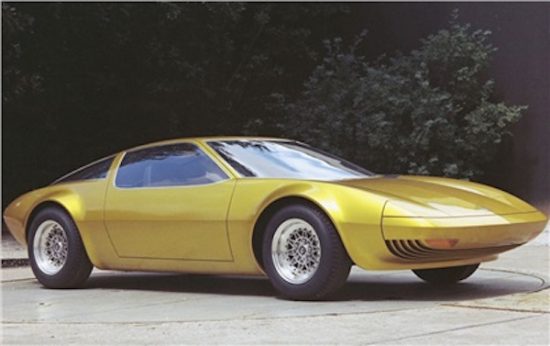
I don’t know if this clay model was done in Germany just to make spies think it was an Opel or if it was being proposed as an Opel with a reciprocating engine.
Back in Blighty Falconer threw in any old engine to get it running, in this case a Vauxhall Cavalier but soon found a Mazda 13B rotary engine to go in its place so as to at least make it a rotary engine sports car. The trans from a Cadillac front-wheel drive went into it. He repainted in its original Candy Apple Red color, though it had been silver when shown in Europe.
Now imagine what happened when some time later Falconer shows up with the running rotary powered Two Rotor Corvette at the NCRS (National Corvette Restorer’s Society) convention. Pandemonium! Here US Corvette fans can’t buy GM prototypes – no way no how – but some slick talkin’ Englishman drives up with the Corvette equivalent of the crown jewels. Bloody hell!
But there was another darker reason that GM didn’t want the car around the U.S. Not only was it a reminder that they couldn’t beat tiny Toyo Kogyo (the real name of Mazda) in making a rotary, but Zora Arkus Duntov (called “the father of the Corvette” though he was hired well after the Corvette was in production), had one too many chardonnays over there in Grosse Pointe at the Yacht Club and let slip to a reporter that, yes, it was true it was built on a Porsche 914 platform. Yes, GM had spent $2 million making the world’s most expensive custom Porsche!
(You wonder if, at auto shows, they had shooed engineers from other firms away from taking a peek at the underside, lest they discover their sin…)
And so it is, one of the most beautiful show cars ever made by GM (except for the nose, used later in the Chevrolet Monza) has to live its days in ignominy…an heir to the throne thoroughly disinherited….
Let us know what you think in the Comments.
THE AUTHOR Wallace Wyss, as an ad man, was involved in writing ads for the Corvette and a Lancia. At present he is a fine artist painting sporting cars.
UPDATE
Myron Vernis sent in this note below and the photos.
Hi Mike,
I saw this post on Wally Wyss’s article on the mid engine Corvette. Here are some photos of an original GM rotary engine and the team.
Best,
Μyron
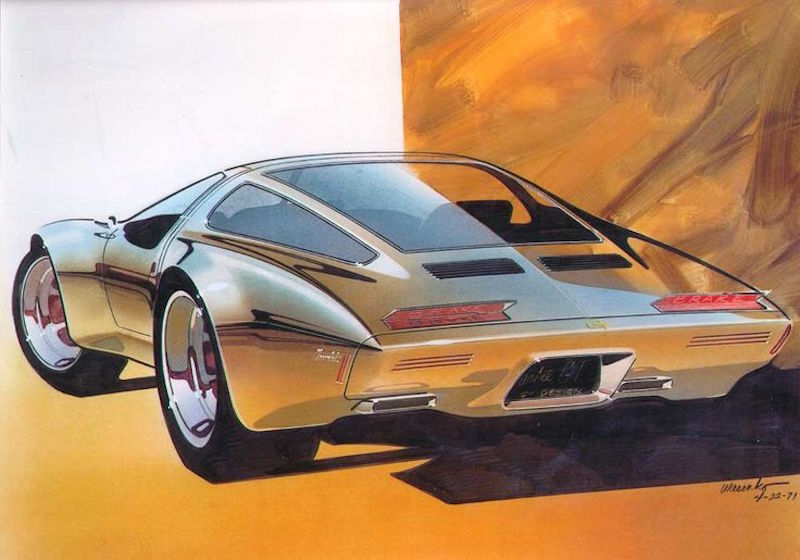
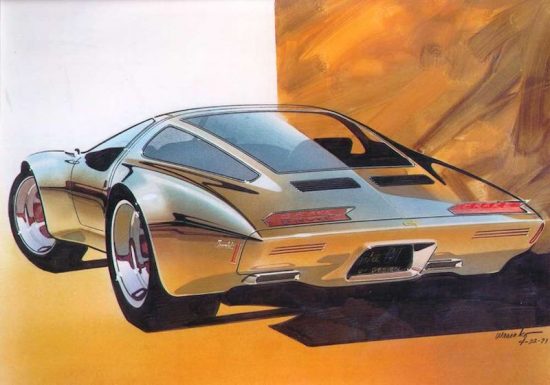

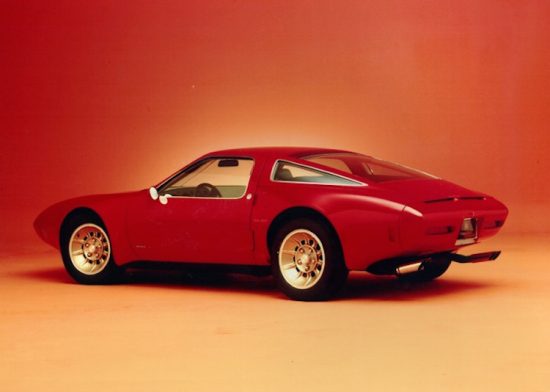
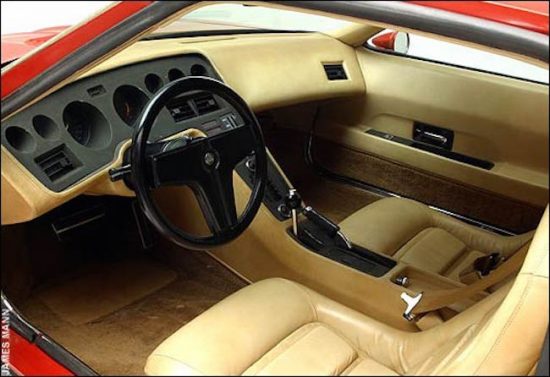
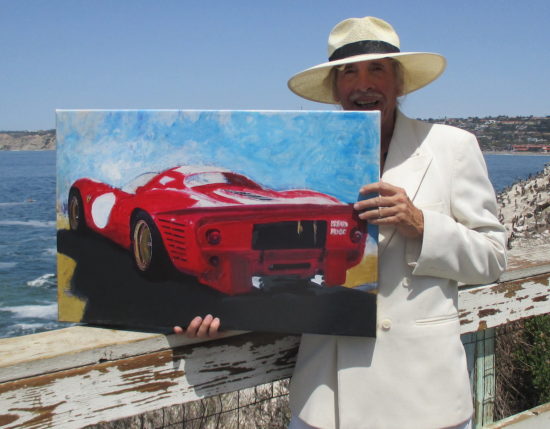
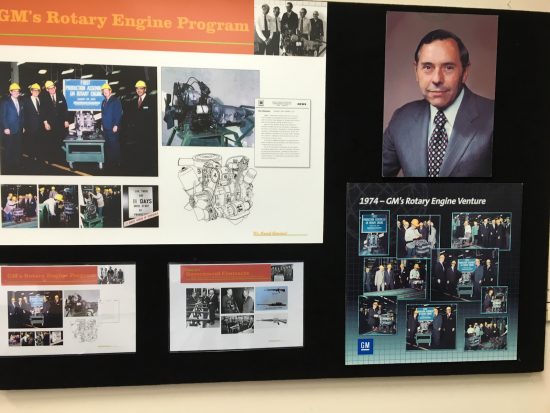
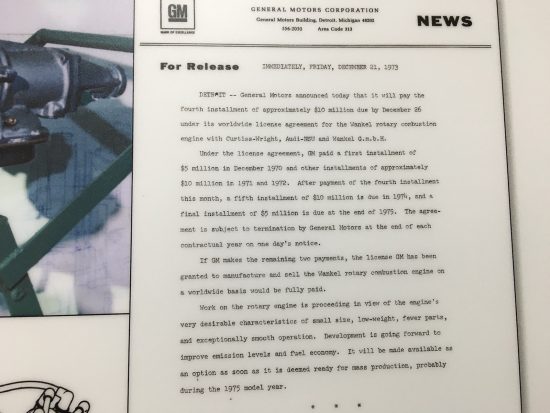
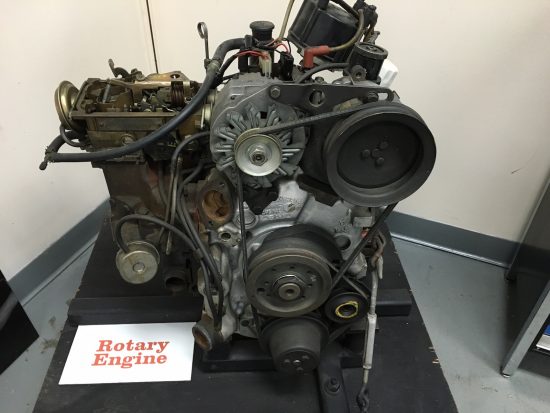
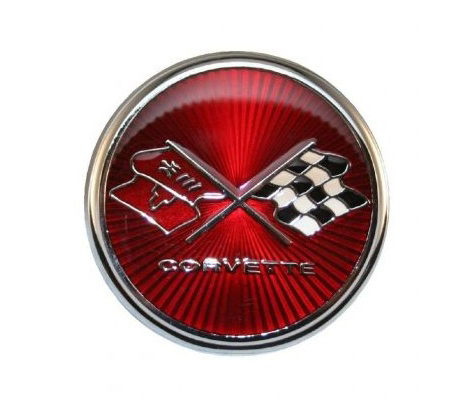


Cool story; would live to hear your driving impressions of the car. A surviving GM rotary engine can still be seen at the Ypsilanti Automotive Heritage Museum in, you guessed it, Ypsilanti, Michigan. The engines were developed and intended to be built at the Hydramatic plant.
If I could suggest one small correction; Mazda was not the first company to mass produce rotary engine cars. NSU built over 2500 Wankel Spiders before the first Cosmo Sport was finished. Technically, the Cosmo wasn’t even a true production car. They were hand built at the rate of one per day. Only about 1100 were built over a five year span.
That was a fascinating piece and very entertaining! Thanks Mike!
I was Customer Relations at Mazda during this period. The Two Rotor that GM & AMC were working on was about double the trochoid dimensions of the Mazda, and the hoop a friend of mine in Painesville OHIO had as a souvenir from where it was cast. The flaw was in sizing i so big it would have never worked hgh enough on the thermodynamic cycle to get into an efficient operating regime. Rotaries at low rpm leak compression from the high pressure lobe into the adjacent one. Spun fast enough and that becomes insignificant. Run wide open as well and they also get as efficient as a piston engine. Wonderful for a boat or snowmobile or airplane. Nothing to fly apart and catastrophically fail. But just not economical. They also cannot have enough combustion space at the equivalent of Top Dead Center to be Diesel, although they could run as multiple fuel no problem, so long as some two stroke oiling was provided. A Hydrogen powered experiment at Princeton failed for that reason, but I cannot remember if I told Dr. Bracco when I took him some spare hoops.and plates to replace his burnt ones.
One other problem of the Rotary. Neither GM nor most any other carmaker had the machining tool expertise that Toyo Kogyo had. Keeping the arc shape ring lands of the sides of the iron Trochoid rotor accurate and doing so economically was quite a feat. They could have certainly bought such parts from Mazda probably had they needed but such humility was not popular. And wthout competitive bidders the cost would have been uncontrollable.
Curtiss Wright did the lions share of the applied engineering and wound up with most of the applicable patents for the original 1903 Cooley theoretical design. I think even NSU and Felix Wankel were licensees of C-W when they did their on rotor and later two rotor Ro-80. The latter car looked like a higher quality 1986 Taurus prototype only done two decades earlier! Jan Norbye gave me an autofgraphed copy of his excellent book on the Wankel back in the days it was still considered the next viable power plant. Oddly enough, today it would be very suitable in package as a one rotor and wound rotor gas electric hybrid owing to its compactness and barrel shape.
Please correct 1093 to read 1903! That is as far back as the idea of a trochoid inner rotor revolving hula hoop fashion around a sun gear would keep all three tip seals in continuous contact with the peanut shaped (epitrochoid) outer housing. Thus each of the three faces would present themselves to expanding and contracting enclosed volumes which could produce four cycle equivalency three times per rotation of the rotor. Hence the sun gear would get propelled at 3000 rpm while the rotor activity was only effectively 1000 rpm. With two rotors in opposition you had a seven moving part “six cylinder” analogue. Balance was inherently possible with minor rotorshaft counterweighting. Oil cooling to the inside of the hollow rotor was necessary but easily sloshed into and out of the rotor from the side, and drained back into what was equivalent to a dry sump resevoir in the posiion of an ordinary oil pan.
Thanks Mike, for an interesting article. Wallace Wyss always has insightful and entertaining stories. Many Corvette fans have been clamoring for a mid-engine design for a long time. Probably to it’s credit, GM has resisted, remaining true to the Corvette’s traditional configuration. Continued development, bolstered by a very successful racing program, has resulted in a world class supercar. But, does anyone see a mid-engine Corvette in our future, maybe near future?
Great article Wallace – these sorts of stories are what make cars so interesting. Every time I learn something new about the people, the backstory, the politics of a car design (especially one offs) the car always looks a bit different to me.
Little to no chance we’ll ever see a rotary powered Vette in the future. The next most likely candidate for the Vette will be a hybrid gas electric.
I read that AMC was planning to use the rotary engine by GM in their Pacer vehicle with a front wheel drive. The deal failed and they used something else in the pacer with a rear drive system. A front wheel drive would give it a lot more room inside that it does with a rear wheel drive.
Neat story. I have a photo of the GM Rotary Diesel team. Very few knew about this group and project at GM Research in the Tech Center. I can email you a photo and team members if you send me a link.
Hi Nick,
I would love to see the photo – email it to michael.gulett@gmail.com and I will share it with Wallace.
Myron Vernis sent in some relevant photos which have been added to this post.
GM did make a mid-engined sportscar: the Pontiac Fiero. Of course, Pontiac is dead and buried now.
I’m wondering about this bit: “Now because the engine was a midship, they took an automatic developed for a front wheel drive car and turned it around.”
Why would they turn it around? Wouldn’t the engine in the FWD car be in front of the transmission, just like in a mid-engine one? At least it has been in most FWD cars after WW2 (before then, it was usually way out front, but afterwards only very rarely).
So to use a FWD transmission in a rear-engine car, you’d have to turn it around (and then reverse it’s rotation, or you’d get one forward gear and many reverses), but for a mid-engine layout you just have to move it straight backwards AFAICS.
I’m Tom Falconer, and have looked after this car for 34 years . Wally never lets the facts get in the way of a good story, but this is essentially correct. Over the last few weeks we have recommissioned the 2-rotor ready for a test and history feature for a major classic magazine. Even better, I have just located an original GMRCE engine in Michigan and aiming to purchase and ship this back to England shortly. Mean while follow Corvettetomfalconer on Instagram or Tom Falconer on Facebook
I was told you were offered a two rotor and turned it down because you
were not willing to re-engineer the car for that engine from the Mazda. Changing to the engine it was designed for will improve the car’s value immeasurably.
I was told the story of how you got it by GM insiders, and have known the car’s designer, Kip Wasenko, for over 50 years. Nonetheless I think it’s great when old dream cars are rescued. I hope GM can come to recognizing it as one of its own children, sort of “a brother by another mother. ” When Chevy comes out with a production mid engine Corvette that would be a perfect time to have all the mid-engine Corvette prototypes on display, though of course the Four Rotor will have to have its body changed for the Aerovette every few hours.
That 2 rotor GM Wankel was for a 74 Vega option then after the first delay, the Monza 2+2 not the Corvette